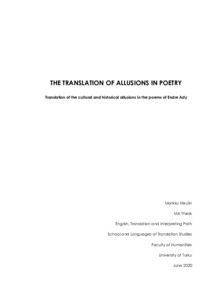The Translation of Allusions in Poetry : Translation of the cultural and historical allusions in the poems of Endre Ady
Nikulin, Markku (2020-08-11)
The Translation of Allusions in Poetry : Translation of the cultural and historical allusions in the poems of Endre Ady
Nikulin, Markku
(11.08.2020)
Julkaisu on tekijänoikeussäännösten alainen. Teosta voi lukea ja tulostaa henkilökohtaista käyttöä varten. Käyttö kaupallisiin tarkoituksiin on kielletty.
avoin
Julkaisun pysyvä osoite on:
https://urn.fi/URN:NBN:fi-fe2020100778350
https://urn.fi/URN:NBN:fi-fe2020100778350
Tiivistelmä
In my thesis I have studied the translation of the allusions in the poetry of the Hungarian poet Endre Ady (1877-1919). Ady’s poetry was rich in allusions intertwined with the history and culture of Hungary and in my thesis I have sought to examine how transla-tors try to translate these allusions into English, Finnish, German, Czech, Slovak, Romanian, Dutch and Portuguese and which factors affect the process of translating them. As main factors affecting the process, I have chosen the geographical and cultural distance between the cultures, the poetic form and the assumed use of the target text.
As theoretical background I draw on the translation theories by Eugene Nida and the Skopos theory created by Hans Vermeer and Katherine Reiss. For classification and analysis of allusions I have applied the studies by Ritva Leppihalme and for the classification of translations I have relied on a system by Ildikó Pusztai-Varga. For the special problems attached to the translation of poetry I have used the study by Barbara Folkart.
In my thesis I show that in the translation of allusions of Ady’s poetry there are two factors that complicate the process, namely the geographical/cultural distance, which makes the allusions more difficult to understand, and the compactness of the poetic form, which does not allow explaining. Beside these the assumed purpose of the target text is also of great importance, as the requirements of the poetic form may be abandoned, if the purpose is to convey only the information, not poetry. Opinnäytetyössäni olen tutkinut unkarilaisen Endre Adyn (1877-1919) runojen sisältämien alluusioiden kääntämistä. Adyn runous on täynnä Unkarin historiaan ja kulttuuriin liittyviä alluusioita ja olen tarkastellut sitä, miten kääntäjät kääntävät näitä alluusioita eri kielille (englanti, suomi, saksa, tsekki, slovakki, romania, hollanti ja portugali) ja mitkä tekijät vaikuttavat käännösprosessiin. Tärkeimmiksi käännösprosessiin vaikuttaviksi tekijöiksi olen valinnut maantieteellisen ja kulttuurisen etäisyyden lähtö- ja kohdekulttuurin välillä, runon muotoon liittyvät tekijät sekä kohdetekstin käyttötarkoituksen.
Opinnäytetyöni teoriapohja tukeutuu Eugene Nidan käännösteorioihin sekä Hans Vermeerin ja Katherine Reissin luomaan skoposteoriaan. Alluusioiden luokittelussa ja analyysissa olen soveltanut Ritva Leppihalmeen tutkimuksia, käännösten luokittelussa taas olen turvautunut Ildikó Pusztai-Vargan kehittämään ryhmittelyyn. Runouden kääntämiseen liittyvissä erityiskysymyksissä olen käyttänyt apuna Barbara Folkartin tutkimuksia.
Tutkimuksessani päädytään siihen tulokseen, että käännettäessä Adyn runouden sisältämiä alluusioita ennen kaikkea kaksi tekijää monimutkaistaa prosessia: toisaalta maantieteellis-kulttuurinen etäisyys, joka tekee alluusioista vaikeampia ymmärtää kohdeyleisölle, toisaalta runouden tiivis muoto, joka ei mahdollista selitysten tai lisäysten liittämistä tekstiin. Näiden lisäksi myös merkitystä on myös kohdetekstin käyttötarkoituksella. Jos tarkoituksena on välittää yksinomaan lähtötekstin informaatiota eikä esteettisiä arvoja, koko runomuoto voidaan hylätä kohdetekstissä.
As theoretical background I draw on the translation theories by Eugene Nida and the Skopos theory created by Hans Vermeer and Katherine Reiss. For classification and analysis of allusions I have applied the studies by Ritva Leppihalme and for the classification of translations I have relied on a system by Ildikó Pusztai-Varga. For the special problems attached to the translation of poetry I have used the study by Barbara Folkart.
In my thesis I show that in the translation of allusions of Ady’s poetry there are two factors that complicate the process, namely the geographical/cultural distance, which makes the allusions more difficult to understand, and the compactness of the poetic form, which does not allow explaining. Beside these the assumed purpose of the target text is also of great importance, as the requirements of the poetic form may be abandoned, if the purpose is to convey only the information, not poetry.
Opinnäytetyöni teoriapohja tukeutuu Eugene Nidan käännösteorioihin sekä Hans Vermeerin ja Katherine Reissin luomaan skoposteoriaan. Alluusioiden luokittelussa ja analyysissa olen soveltanut Ritva Leppihalmeen tutkimuksia, käännösten luokittelussa taas olen turvautunut Ildikó Pusztai-Vargan kehittämään ryhmittelyyn. Runouden kääntämiseen liittyvissä erityiskysymyksissä olen käyttänyt apuna Barbara Folkartin tutkimuksia.
Tutkimuksessani päädytään siihen tulokseen, että käännettäessä Adyn runouden sisältämiä alluusioita ennen kaikkea kaksi tekijää monimutkaistaa prosessia: toisaalta maantieteellis-kulttuurinen etäisyys, joka tekee alluusioista vaikeampia ymmärtää kohdeyleisölle, toisaalta runouden tiivis muoto, joka ei mahdollista selitysten tai lisäysten liittämistä tekstiin. Näiden lisäksi myös merkitystä on myös kohdetekstin käyttötarkoituksella. Jos tarkoituksena on välittää yksinomaan lähtötekstin informaatiota eikä esteettisiä arvoja, koko runomuoto voidaan hylätä kohdetekstissä.
Samankaltainen aineisto
Näytetään aineisto, joilla on samankaltaisia nimekkeitä, tekijöitä tai asiasanoja.
-
Translators' Status in Platform-Based Translation : Finnish Fiverr Translators as a Case in Point
Signell, Joose (15.05.2024)This study investigates how work on digital labour platforms affects translators’ status, or occupational prestige, which has generally been believed to be quite low. In the last twenty years, empirical studies have also ...avoin -
Translation Strategies and Translations of Realia in the Finnish Translation of The Cruel Prince
Liljeqvist, Anna (13.05.2025)This thesis explores the translation of nomenclature from The Cruel Prince (2018) by Holly Black. The aim of this research was to understand what translation strategies were used and what other effective factors were ...avoin -
Translating Womanism: A feminist translation analysis of Alice Walker’s The Color Purple and its Finnish translation Häivähdys purppuraa
Hamara, Julia (17.05.2017)The aim of this thesis is to incorporate the third-wave feminist perspective into a translation analysis of a literary feminist text and its translation from English into Finnish and to examine how the feminist features ...


